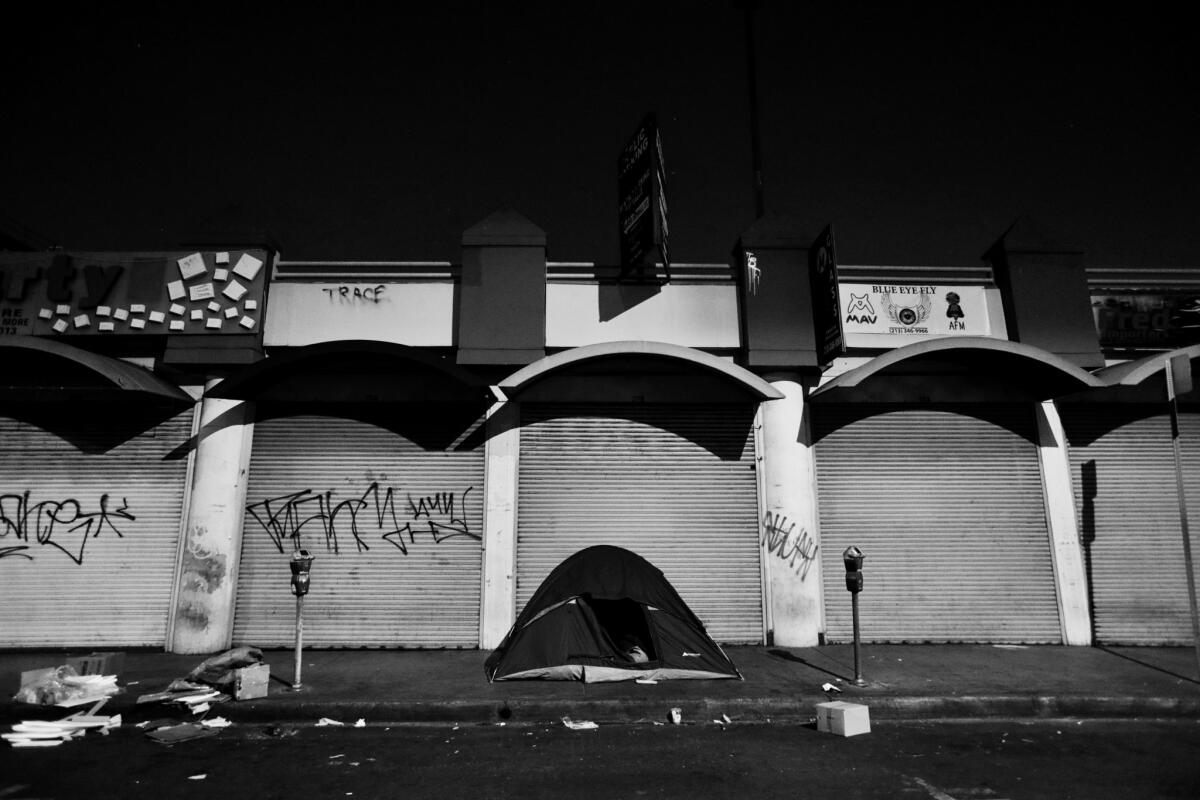Editorial: L.A. has a long history of failure on homelessness. It needs leaders who will take responsibility
Two years after Los Angeles city leaders said they were about to declare (although they never actually did) a state of emergency over a deepening homelessness crisis;
18 months after county supervisors called on the state to declare such an emergency (it didn’t);
More than a year after voters overwhelmingly agreed to pay $1.2 billion to house people now living on the street;
Eight months after L.A. County voters raised their sales taxes by a quarter-cent on the dollar to pay for mental health care and other support services for the homeless;
And now, deep into another winter in which tens of thousands of people huddled in flimsy tents or with no shelter at all face violent Santa Ana winds, chilling nights and seasonal downpours —
Where are we?
How many people have we housed, or at least, how many are we on track toward housing? Is Los Angeles setting the national standard for rapid and effective response to a vexing problem? Or are its leaders merely mastering the art of appearances while passing the buck and hoping things turn around?
Who knows? L.A. homelessness stats are spread among obscure reports from city, county and federal agencies.
And you’ll learn nothing by attending a meeting of the body charged with ending homelessness or hearing the report from the homelessness czar — the point person reporting directly to both the city’s mayor and the county Board of Supervisors. That’s because there is no committee and no czar with sole responsibility for ending homelessness. Or rather, there are many committees and many sub-commanders, which is almost the same as there being none at all.
Who’s in charge here?
The question echoes unanswered through the streets of this notoriously fractured, siloed and balkanized metropolis, where the city-county structure and the political culture too often allow politicians to wriggle their way out of accountability. The city of L.A. and 87 other cities each control their own land-use policies and therefore determine what housing can be built, and where and for what purpose, while nearly every other aspect of human service for the destitute and miserable — including mental health, public health and addiction treatment — is handled by the massive Los Angeles County government, with its five co-equal supervisors and its virtually unknown chief executive.
There may be no more telling example of the poor working relationship between the city and the county — historically, anyway — than in the death of a homeless Angeleno on the street more than a quarter of a century ago. The city responded the way it knew best: by suing the county (for failing to deal with poverty). The Board of Supervisors struck back by blaming the city (for restrictive housing policies that put shelter beyond the reach of the needy). Lawyers settled the suit by creating a new entity — the Los Angeles Homeless Services Authority, better known as LAHSA — to integrate the city and county responses to homelessness. Instead of solving the problem, however, that began a decades-long battle over control of both the agency and its leadership.

Now, the county’s homeless population has ballooned to nearly 58,000. More than 800 homeless people died on the streets last year in Los Angeles, which puts into tragic perspective the single death that led to the creation of LAHSA in the 1990s.
The current LAHSA executive director, Peter Lynn, has not become L.A.’s single point person on homelessness. LAHSA collects and distributes money and performs the annual homeless count in order to compile the numbers demanded by the U.S. Department of Housing and Urban Development, but Lynn does not direct L.A.’s homelessness operations. Lynn, L.A. Mayor Eric Garcetti and the Los Angeles County Board of Supervisors all argue that they work better together on homelessness than ever before, and that may well be true — but they move forward with their own distinct programs, policies, outreach and messaging.
Some L.A. homelessness advocates look longingly toward San Bernardino County, where the Board of Supervisors contracted with former county CEO Greg Devereaux to preside over regular command sessions where department chiefs are grilled on the latest homelessness data. Where are the hot spots? Who are the newly homeless? What’s blocking us from housing them? Who is responsible for removing those blocks? Why haven’t you done it yet?
But San Bernardino’s homelessness challenge is tiny compared with L.A.’s. Here, a clearly frustrated City Atty. Mike Feuer is calling for a “field general” in charge of logistics for the city, evaluating the data, instilling a sense of mission, pressing council members to house a few more people in their districts, operating in a direct link with outreach workers using hand-held devices to instantly find available beds and other services with people in need — and operating as an empowered emissary of the mayor.
Yet such a czar would only be as powerful as the mayor who appointed him or her. And in L.A., the mayor lacks legal authority to override City Council members, who can and do frequently say “no” to proposed housing and mental health facilities in their districts. And neither the mayor nor the czar would have control over the county, which supplies the services, or the region’s other 87 cities. Czar-like powers would be possible only if council members were to relinquish some land-use and budget authority through something like an emergency declaration. And remember, they never did that. They gathered together and said they were going to do it, and much of the world’s media mistook that cleverly phrased promise to do it as actually doing it. You’ll find news stories saying they did it. But they did not.
Meanwhile, at the county, the Board of Supervisors put experienced official Phil Ansell in charge of its Homeless Initiative. But as Ansell recently reminded the panel overseeing expenditure of Measure H sales tax money, the real roadblock to dealing effectively with homelessness — now that the money is coming in — is siting homeless housing. The county has no control over that, except in places where there is no city government, such as Marina del Rey (where land costs are prohibitive).
So now what? Do we give up?
Hardly. We instead distinguish between authority — which is granted by city charters and ordinances — and power, which is exerted by leaders with backbones and a willingness to spend their political capital when it really matters. Garcetti could, if he wanted to, call out those council members who refuse to permit construction of permanent supportive housing or even plain-old affordable housing in their districts. He could shame them, cajole them, buoy them, empower them, pressure them. To date, he has done too little of this. In the months ahead, regardless of his plans for his political future, he needs to stay focused on solving the problems that face the city here and now.
At the same time, the city, the county and LAHSA could demonstrate their supposedly improved collaboration by creating a single point of contact for homelessness response.
The county is retooling its 211 telephone program to direct callers to services for homeless people, and that’s good. As it is now, most people don’t know whom to call when encountering a person on the street who may be ill, or who may need a place to spend the night, or who may seem threatening? Do you call the police? The paramedics? 911?
Now, it’s 211 — but how many people know about it, or know whether to call that L.A. County number or 311, the L.A. city number? Whom do you call if you’re in West Covina? Compton? Santa Clarita? Is it asking too much to give residents, whether comfortably housed or otherwise, a single point of contact for help with homelessness or indeed any other service regardless of municipal boundaries? We certainly do that with 911 and calls for emergency service.
The county is expected to soon have an online dashboard showing expenditures of Measure H funds together with outcomes — how many housed, how many served with mental health care and the like. And that’s good, but why can’t we expect the same website to also inform residents of how the city’s Proposition HHH housing bond funds are being spent, including how many units are being built, how many have broken ground, how many are in the pipeline? And how many units are being built in Long Beach, Burbank and the county’s other 85 cities? Homelessness transcends city limits. So should the solutions and the accountability measures put in place by county and city officials.

Los Angeles is not like San Francisco or New York, where the city and county are combined in a single government. Here, cooperation and silo-busting are essential, and are not yet where they need to be. Every city and county elected official must be held to answer, individually and collectively, on a regular basis, for clearly communicating how well their programs are working, how many people they have housed — and how many they are leaving on the street.
It should go without saying that homelessness is an issue of a different magnitude than, say, fixing potholed streets or ironing out the problems in a new recycling program. This is a humanitarian tragedy of extraordinary proportions that the citizens and elected officials of this city and this county are morally obligated to solve by working together, committing resources and, in some cases, making sacrifices.
To that end, though, the people in charge need to show that they know what to do, that they are making tough decisions, that they are getting the most for our money and that the problem is receding. That’s what leadership requires.
This is the sixth in a series.
More in this series:
3. NIMBYISM
5. Compromise
Read more from the Times' “Without a Home” series
A cure for the common opinion
Get thought-provoking perspectives with our weekly newsletter.
You may occasionally receive promotional content from the Los Angeles Times.







